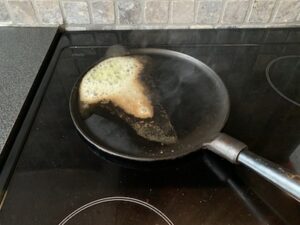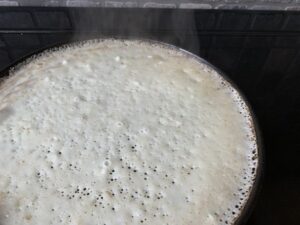LIFE WITHOUT GLUTEN – A SURVIVORS GUIDE – PT2: REACHING A PLATEAU & BUILDING A ROCKET SHIP (ALSO CREPES)!
If you’ve realised that there are still great options for you for dining out and what complications to expect both socially and practically, there is still a whole lot you can do to get back to a normal life full of great food and awesome desserts. This article outlines the final strategy for reclaiming your life if it has gone gluten free not by choice but by necessity. If you’re avoiding gluten for ideological reasons (like Instagram trends) you’re kind of crazy, but will find this highly useful too.
Also to put my wallet where my mouth is, there are crepes in here. Read now for instant relief and gastronomic satisfaction.
If you’ve realised that there are still great options for you for dining out and what complications to expect both socially and practically, there is still a whole lot you can do to get back to a normal life full of great food and awesome desserts. This article outlines the final strategy for reclaiming your life if it has gone gluten free not by choice but by necessity. If you’re avoiding gluten for ideological reasons (like Instagram trends) you’re kind of crazy, but will find this highly useful too.
Also to put my wallet where my mouth is, there are crepes in here. Read now for instant relief and gastronomical satisfaction.
Read the first part!
If you haven’t read the first installment – you can go here to read it:
Life without Gluten: A survivors guide – Part 1: Calamities, Stomach cramps and Absolutely no Cake!
The tactic of selection & avoidance
A great idea is to start focusing on cuisine that by nature doesn’t use a lot of gluten. This goes both for eating out and cooking at home. If you’re in a rural part of the world or a small town this might be harder as both dining out alternatives as well as the some of the base food stuffs needed aren’t generally available. Needless to say some areas of the world depend more on gluten rich produce than others. My three favourite kitchens are, in no particular order, Japanese, Vietnamese and Korean. If I had to be minimalist and never eat anything but food from these countries I would be pretty happy. As it happens any of them will set you up with a good chance of eating delicious meals without gluten. If you can skip some of the obvious stuff, like inhaling a massive bowl of ramen (wheat noodles) and avoiding soy with high gluten content there is a lot of food on offer.
Japanese food and Gluten
The Japanese for a long time lived relatively isolated from the rest of the world, with food based on what could easily and naturally be produced within an island nation. While some habits have changed over time, like eating beef (nowadays some of the worlds best beef cattle is raised in Japan) others haven’t. Bread for example isn’t at all the mainstay that it is compared to parts of Europe or the North Americas. And the basis of traditional Japanese food is quite gluten friendly both in what kind of cooking methods and philosophy applied as well as the ingredients used

The Japanese kitchen is pre-occupied with clean unobscured flavours based on quality ingredients. Soaking ingredients in various sauces or mixing many ingredients together is not something that is particularly significant for Japanese cooking. This makes Japanese food, with its healthy bias towards vegetables, fish and meat as well as cooking techniques not naturally geared towards a lot of wheat, quite practical from a gluten free perspective.

Phở sho – Vietnamese Food
Considering the sheer awesomeness of Vietnamese food, the herbs, the sweet and savoury, the fresh vegetables and the diverse culinary influences, the Vietnamese kitchen is also fairly mild on the gluten allergic state of being.
While, like Japanese food, some of the deep fried stuff will contain gluten, some dishes which you might assume would be full of gluten can easily be made skipping gluten (more about that later).
The national dish of Phở, rice noodles in a super savoury broth, with herbs and vegetables and a topping of thinly sliced beef, contains no gluten in it’s common form. So if your therapy bills have sky rocketed due to not being able to down a massive bowl of ramen whenever the fancy strikes you – get a hold of yourself and enjoy some Pho!
And you’ll find many other awesome Vietnamese eats like Bun Cha, summer spring rolls and the vietnamese version of the Galette, Ban Xiao frequently made without gluten.
Korean and the Celiac
No that’s not the title of a Kpop song by Izone. I think it’s non controversial to state that Korean food is genius. It not only combines heat, spice, sweet & savoury flavours with tangy fresh pickled vegetables and of course the Mighty Kimchi. Korean food is also innovative and constantly evolving. Everything from ingenious indoor barbecue systems to pragmatic usage of tools you just don’t see in many other cultures (pliers, scissors and other practical implements of food management).

Add to that a healthy dose of cross-over, adopting dishes from Asian neighbours as well as historically incorporating foreign influences like surplus and black market ingredients from US army bases – Korean food is amazing. The Korean Cuisine doesn’t give a sh#t about you stomach condition and that’s just how it rolls. And much a like a blinged out, Swarowski encrusted tank, you know you need it.
While slightly trickier than Japanese or Vietnamese for the gluten allergic because the numerous different prefabricated condiments and sauces that are commonly used that will in many cases contain gluten. However there are a lot of dishes that, if you can control the soy used (soy is usually produced with wheat as part of the fermentation process) leave a lot of staples and favourites in play: Bimbimbap, Japchae, different barbecues, mung bean pancakes, different jeons/Korean pancakes… even Teokbokki, the infamous Korean rice cakes, are served in multiple possible gluten free configurations.
The tactic of control
While there is absolutely no reason for you to give up on dining out there will be times when you will feel discouraged. Your dinner company, quite understandably, won’t have a great deal of understanding for your less than liberal approach to restaurant and food exploration.
Because really, if you aren’t yourself risking either being sick or just not having that many options or personally experiencing the fact that your dietary limitations are making dining out a lot rarer (and perhaps then even a bigger deal when they do occur), it’s not that realistic to expect your friends to be aligned with your food agenda. And getting new friends with similarly dysfunctional intestinal complications may not be realistic nor the best option. This means you also need to use a second mitigation strategy:
you need to learn how to make great gluten free food that both you and others would want to eat.
Holy Sh#t!
If your mind just turned into instant white noise, I completely understand. You either, for some reason, don’t cook that well OR you understand the challenge of converting your current kitchen skills into awesome gluten free cooking skills. And believe me, I was at this point of giving up too. But then I thought, in the immortal words of Chris Dean of the Redskins:
Up your bum – it can be done!
And even though it’s completely fair to say that I’m all about deriding wilfully ignorant people, I’m also all about providing solutions. So in order to do that I’m going to outline how to think about cooking gluten free to avoid the common pitfalls and disappointments. But I’m also going to share my recipes for cooking awesome food that will warm the cockles of your heart and please both your friends and your partner (and kids if you are a parental unit)!
And all of the food covered in these recipes will be both delicious as well as highly presentable and, as it happens, all gluten free.
To start you off, as you might be in a dark state of newfound celiac awareness and have recently realised your dessert habits might be forever changed, I will now sort you out with a simple crepe recipe that will get you past your current dessert depression. Crepes are flexible as you can fill and dress them in multiple ways and they are the basis for some delicious and highly visually pleasing desserts like crepe mille feuille!
And unlike Instagram chefs standard claims of “will work every time” I claim no such thing.
If you are a bit of an idiot you may need to read the recipe a few times, no shame in that. If you are of average talent just follow the recipe – it’s pretty easy, you don’t need many ingredients and the only vaguely rare tool will be a cast iron crepe pan. This is a perfect breakfast for hungover friends or twin daughters needing fuel for the weekend or simply when you want an easy to make and tasty treat.
Crepes, Galettes and Pancakes
Just to straighten some basics out: I’ve observed some confusion as to Crepes and Galettes and the terms used interchangeably. While it’s not essential (but recommended) to understand the intricacies of French cuisine, this part is quite simple: both crepes and galettes are thin pancakes but the crepe is the term for dessert styled pancakes and galettes is the term for the typically cheese, vegetable and protein filled main course variation. In Sweden, where I live, Crepes are called Pancakes and Galettes Crepes. But you know, Swedish Natives also spend midsummer doing leapfrogs around a flower covered phallic symbol so I guess these errors of labels are insignificant in the grand scheme of things.
- Easy to make even cooking through tears of gluten allergy sorrow 100%
- Complexity of Ingredients and Tools (Crepe pan) 10%
- Versatility (fill with anything sweet, use to make crepe mille feuille) 98%
Minutes for batter
Seconds per crepe
You’ll get awesome thin crepes perfect for filling with jam, a fruit or berry coulis, cream, nutella, cream and fruits or berries. These crepes taste just like their gluten filled counterparts and the only difference might be that they’ll possibly have a slightly lighter complexion.
The basic recipe is for making one serving of about 4-5 crepes. The recipe scales very well so just multiply ingredients for each serving. One life hack when making crepes according to this recipe is to be aware of the flour used being more dense than regular wheat flour. This means that while you’re frying the pancakes you need to do two things:
Stir the pancake batter mildly between each pancake made, to avoid the batter thickening to much at the bottom of the bowl/container. And for something like every fourth pancake you might want to add a little bit more milk (like a quarter of a deciliter). This part is the one you’ll get better at gauging and might vary a bit with the quality of flour you’re using.
Ingredients (1 serving of 4 crepes):
-
2 dl Milk (0,9 cups)
-
1 dl Glutenfree flour (0,45 cups)
-
1 Egg
-
1 Spoon of melted butter for the batter
-
Additional butter for greasing the crepe pan
Equipment:
- Cast iron crepe pan (ideally. But you can use whatever you have at hand)
- Thin spatula
- Decilitre measure
- Mixing bowl
- Paper towls for quick cleanup
This is how you do it, AKA: The Cooking Instruction
1. Heat Crepe pan
Put the cast iron crepe pan on the stove. If you’re using a thinner pan that heats up very quickly you can skip this. The pan has reached correct heat when butter put in the pan browns in 2-4 seconds. The heat should be at around 65-75% output. Start at the lower range and then increase the heat if needed.
2. Make the crepe batter

- Put the flour in a bowl.
- Add egg/s
- Add the milk last (this in order is to avoid lumps in the batter as far as possible)
Start mixing/whisking the batter. You want to get rid of lumps but not get unnecessary bubbles in the batter.
3. Add melted butter
Put one full spoon of butter in the pan. Let it dissolve and brown slightly but not burn.

Add the butter from the pan to the bowl. Mix it into the batter.

4. Let batter rest (optional)
If you have excessive bubbles or want a batter that’s really easy to use – let the batter rest for 20-30 mins. (If you do, make sure to whisk/stir the batter before starting as it will have thickened towards the bottom of the bowl). If you include this step – take the pan off of the stove top, and remember to start heating it again at least 5 mins before you start frying the crepes.
5. Crepe making
Pour just enough batter to cover into the hot pan.
When the edges of the crepe brown slightly take a thin spatula and work under the pancake.

You may want to work the spatula under the pancake so you know at least 50% or more of the pancake easily comes loose from the pan. Now work the spatula under the pancake, aim for putting the spatula just off centre of the pancake so you can easily flip it over its “axis”.

Flip the crepe.

6. Butter & Repeat
Add more butter if the pan looks dry.
Repeat step 5 for each pancake until the batter is gone. Butter the crepe pan between each or every other crepe as fit.
7. Fill

Good luck! If you liked making the Crepes (and loved eating them), have any questions or just wanna say “hi!” – post a comment!











0 Comments